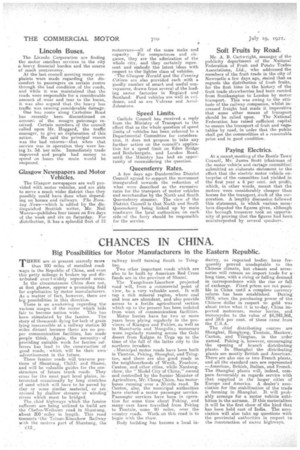CHANCES IN CHINA.
Page 8

If you've noticed an error in this article please click here to report it so we can fix it.
Big Possibilities for Motor Manufacturers in the Eastern Republic.
THERE are at present scarcely more than 100 miles of metalled roadways in the Republic of China, and even this petty mileage is broken up and distributedover widely separated areas.
In the eircunistances China does not, at first glance, appear a promising field for exploitation by motor manufacturers. As a matter of fart, however, there are big possibilities in this direction. There is an awakening regarding the various usages of the motor which bids fair to become nation wide. This has been stimulated by the famine. The story of thousands dying for lack of grain lying inaccessible at a railway station 50 miles distant because there are no proper communication facilities, has made people think. Again, the necessity of providing suitable work for famine sufferers has lead to the construction of good roads, which will be their own advertisement in the future.
These famine roads will traverse portions of :Shantung, Chihli and Shansi, and is-ill be valuable guides for the constructers of future trunk reads. They cross for the most part level plains, intersected occasionally by long stretches of sand which will have lobe paved by clay or some similar material, or are crossed by shallow streams or winding.rivers which must he bridged.
The, chief highways which "the famine sufferers are being utilized to build are the Chefoo-Weilisien road, in Shantung, about 200' miles in length. This road connects 'the' Tsinan-Kiaochow Railway with the eastern part of Shantung, the a an a
railway itself turning South to Tsingtao.
Two other important roads which are also to be built by American Red Crosi funds are in the province of .Shansi.
The Yangchuan-Liaochow projected road will, from en commercial point of view, be a very valuable asset. It will tap a rich mineral region, where coal and iron are abundant, and also provide access to a fertile •agricultural section evbich up to the present has been isolated from want of communication facilities.
Motor lorries have for two or more years been plying regularly in the provinces of Kiangsu and Fukien, as well as in Manchuria and Mongolia; motorcars were regularly running across the Gobi desert from ltalgen to -Urge up to the time of the fall of the latter city to the northern invaders.
• Municipal motor roads have been built in Tientsin, Peking, Shanghai, and Tsingtao, and there are also• good roads in the neighbourhoods of Wusih, Foochow, Canton, and other cities, while Nantungchow, the "Model City of China," Owned and controlled by the fonder Minister of Agriculture, Mr. Chang Chien, has motorbuses running' over a 30-mile road. In Canton, also, the municipal authorities have started a motor passenger service. Passengbr services have been in operation for some time about Peking, and many: cars have travelled from Peking to Tientsin, some 130 miles, over the country roads. Workeori this road is to begin with the thaw.
Body building has become a local in dustry, as imported bodies haee frequently proved unadaptable to the Chinese climate, but chassis and accessories will remain an importtrade for a-
long time, with a rising or falling dernaed in correspondence with the rise or fall of exchange. Fixed prices are not possi ble in -China until a complete currency reform has been established. During 1919, when the purchasing power of the Chinese dollar in respect to gold was about twice what it is to-day, China imported motorcars, motor lorries, and motorcycles to the value of $5,242,368,. and 59.6 per cent, of these Came front the U.S.A.
• The chief distributing centres are Shanghai, Hongkong, Tientsin, Hankow, Canton, and 'I''S'ingtao, in the order named. Peking is, however, encouraging the opening of branch distributing plants. In Shanghai the distributing plants are mastly British and American; There are elso one or two French plants, and all the standard cars are represented —Americas], British, Italian, and French. The Shanghai plants will, indeed, com pare' favourably as regards service with that supplied in the larger cities of Europe and America. A dealer's asso ciation for the stabilization of the trade is forming in Shanghai. It will probably arrange for a motor vehicle exhi bition in the autumn. If this materializes it will be the first show of the kind that
has been held east of India. The asses ciation will also take up questions. with the provincial authorities in respect to the aonstruction of 'slot or highways.
































